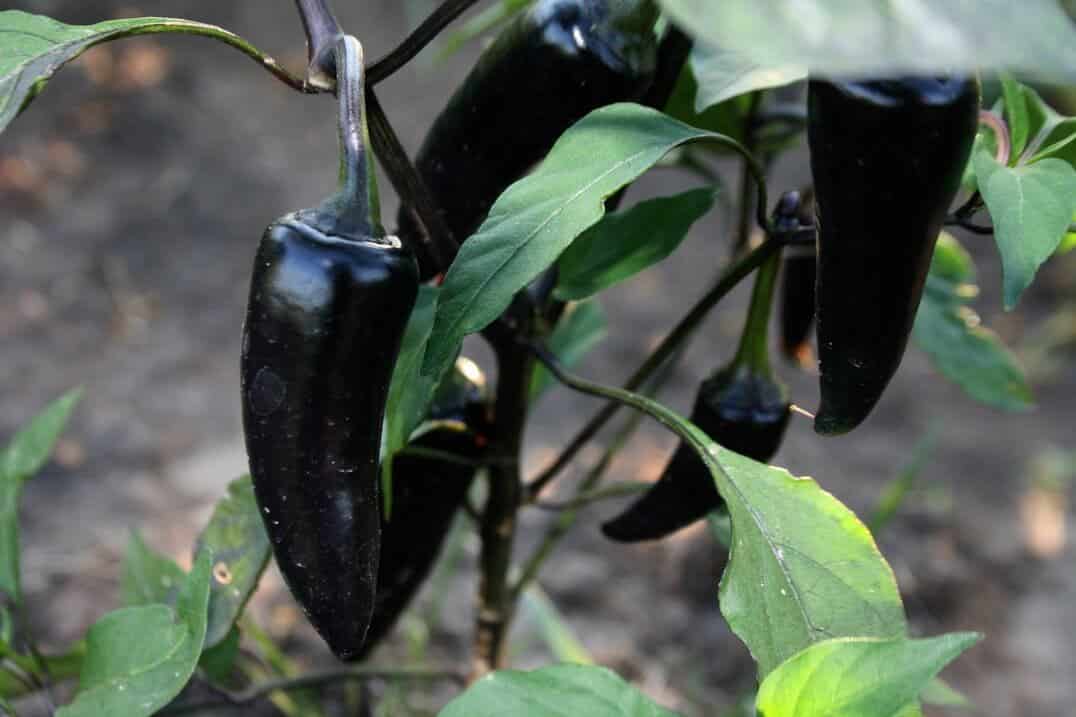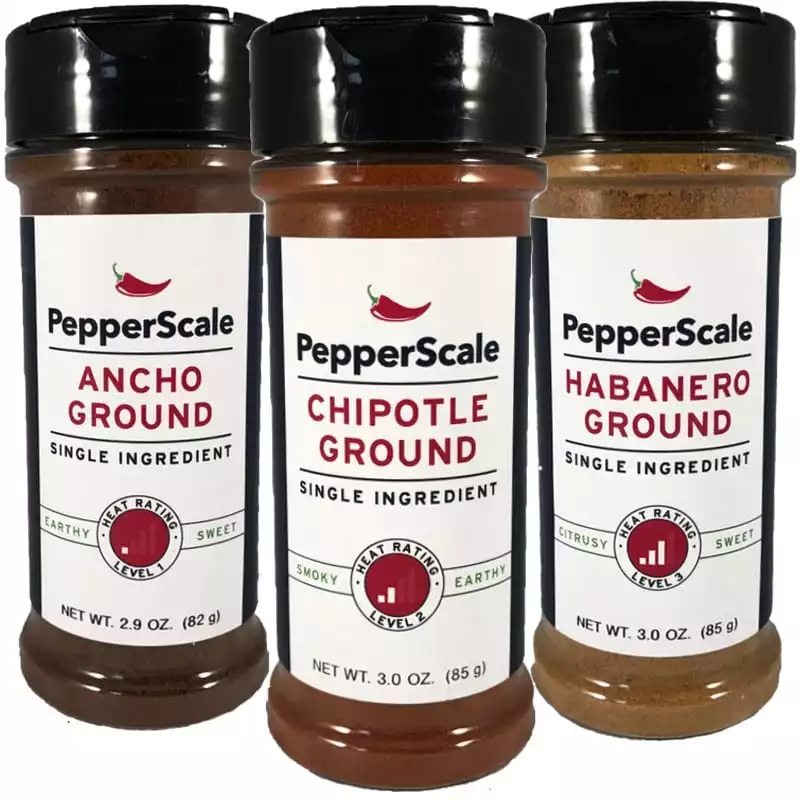Chili peppers are known for their bright and bold colors – from shades of green and red to bold purple, sunny orange, and subtle cream. But few may be as dramatic as black peppers. They may not be as prevalent as the colorful chilies you’ll find throughout the pepper scale, but those that are there catch the eye with their dark hues paired against garden greens. Our black chili peppers guide helps you discover these dark beauties, whether for use as ornamental peppers or for culinary aesthetic. Let’s review your options.
Table of Contents
- Pasilla Pepper
- Black Hungarian Pepper
- Royal Black Pepper
- Black Prince Pepper
- Count Dracula Pepper
- Black Pearl Pepper
- Black Cobra Pepper
- Black Cuban Pepper
- Must-read related posts

Pasilla Pepper
- 1,000 to 2,500 Scoville heat units (mild)
- See our full pasilla pepper profile here.
The pasilla is actually a dried chilaca pepper. While most all dried chilies are dark, the pasilla pepper takes things one step more. There are none more black among dried chilies – not the ancho, not the guajillo, not the chipotle. Most of those are shades of brown and red, while the pasilla takes on a raisiny black finish that fits well with its raisiny like flavor (with a little more fruitiness and a hint of cocoa). This is one of the best flavors on the Scoville scale, and if your need for black chili peppers works with dried chilies, then you’ve met your match.
◇◇◇◇◇

Black Hungarian Pepper
- 5,000 to 10,000 Scoville heat units (medium)
- See our full black Hungarian pepper profile here.
The black Hungarian is the best culinary option among black chilies. With a heat that’s comparable to a jalapeno pepper and a sweetness (particularly in its ripened state that’s much like a Fresno pepper, it’s quite a tasty pepper in the kitchen.
What’s unit to the black Hungarian pepper is its aging cycle. Black is the middle of its maturation cycle on the vine – aging from green, to black, to a jewel tone red. During its black stage, the interior of the walls of the black Hungarian stay green, making for a real dramatic look.
◇◇◇◇◇

Royal Black Pepper
- 5,000 to 30,000 Scoville heat units (medium)
- See our full Royal Black pepper profile here.
The Royal Black is a tiny chili, only up to an inch long. But, boy do the fruits make a dramatic statement. They take on a rich purplish-black hue (aging to a crimson red) and stand upwards from the vine. They pack a heat that can reach as high as a milder cayenne, but more often than not, you’ll receive a serrano pepper level of spiciness. As like many ornamentals, the flavor here is more neutral “peppery” without a lot of depth.
◇◇◇◇◇

Black Prince Pepper
- 5,000 to 30,000 Scoville heat units (medium)
- See our full Black Prince pepper profile here.
The Black Prince is certainly true to its name – featuring purplish-black fruits that age to red. These are small chilies, only 2/3 of an inch long, and they cluster into groups that help showcase the many shades of this chili’s blackish hue. There’s a little sweetness to the Black Prince, but beyond that there’s little depth to the flavor.
◇◇◇◇◇

Count Dracula Pepper
- 5,000 to 30,000 Scoville heat units (medium)
- See our full Count Dracula pepper profile here.
Another aptly named black pepper. Growing up to two inches long, the Count Dracula pepper follows the same color patterns as many of the dark chilies listed here – from a dramatic black to a rich red hue. This pepper’s plant also shares in the darker look – with darker leaves and purple flowers that really enhance the style.
◇◇◇◇◇

Black Pearl Pepper
- 10,000 to 30,000 Scoville heat units (medium)
- See our full Black Pearl pepper profile here.
One of the most popular ornamental peppers around, the Black Pearl is a real jewel, but not only for the tiny onyx black chili peppers themselves that age to a crimson red. The Black Pearl plant brings its own unique beauty to the table, with purple leaves that border on black and purple flowers. It’s a real looker in the garden.
Heat-wise, the Black Pearl has a higher medium heat, much like other ornamental chilies, so take care popping one of these small beauties in your mouth. It may be edible landscaping, but you’ll be in for a surprise – it’s a heat more akin to cayenne than jalapeño.
◇◇◇◇◇

Black Cobra Pepper
- 20,000 to 40,000 Scoville heat units
- See our full Black Cobra pepper profile here.
Want a black ornamental chili with a little more edge? The black cobra pepper is bold with bite. The thin curved chilies jut from the plant like cobra heads aiming to bite. Black is again the middle stage of the aging process, running from green to black to deep red. And again the plant brings its own real style too. The leaves have fine silver hair that just add to this plant’s uniqueness.
Like all ornamentals, you can eat these chilies. But the heat is high (comparable to cayenne pepper) and there isn’t a lot of nuance to the flavor.
◇◇◇◇◇

Black Cuban Pepper
- 40,000 to 58,000 Scoville heat units (medium)
- See our full Black Cuban pepper profile here.
Speaking of edge – the Black Cuban dwarfs the heat of the other black peppers on this list. It’s potent – at the upper-end of medium heat, nearing extra-hot territory. In fact, it’s as hot as some Thai peppers (50,000 to 100,000 Scoville heat units.) The Black Cuban is small, roughly an inch in length, and ages from a dark purplish-black to red as they mature. And as to flavor, they – like most other ornamentals – are more about their looks than flavor (or heat balance.) Think “neutral peppery” and you have an idea of what to expect.
Must-read related posts
- Colorful Peppers Guide: What chilies show off bold colors the most? We list them off.
- The Hot Pepper List: We profile over 150 chilies – search them by name, heat, flavor, and more.
- Ornamental Peppers Guide: Meet some of the chilies grown (and known well) for their unique looks.
